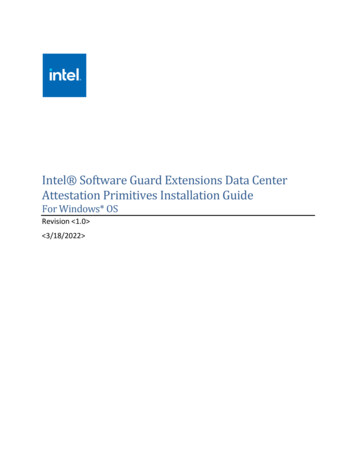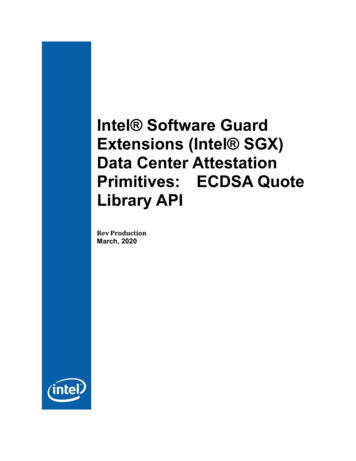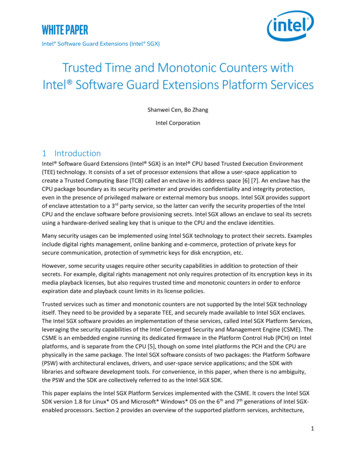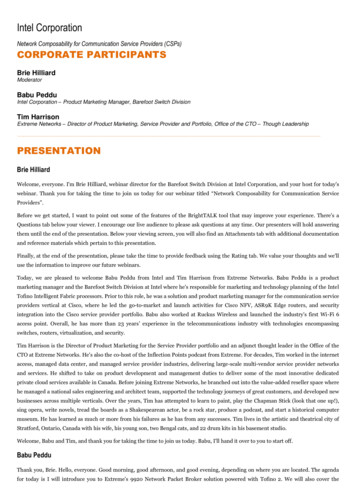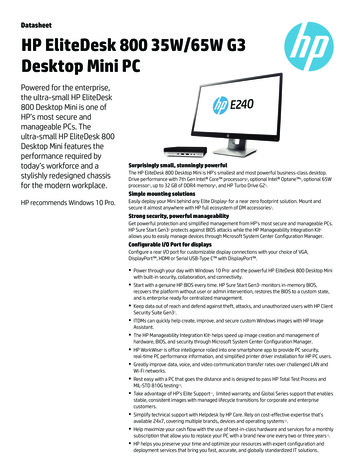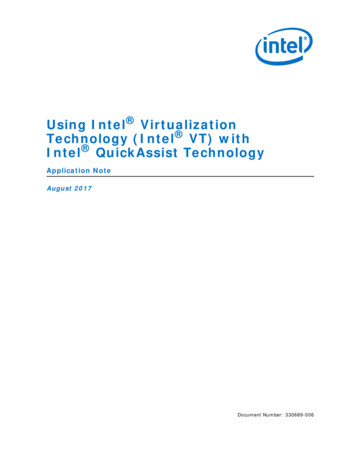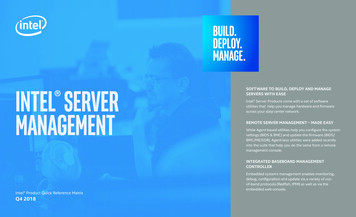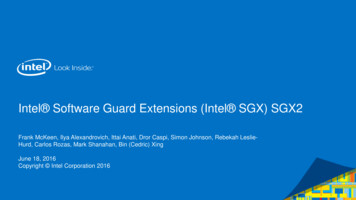
Transcription
Intel Software Guard Extensions (Intel SGX) SGX2Frank McKeen, Ilya Alexandrovich, Ittai Anati, Dror Caspi, Simon Johnson, Rebekah LeslieHurd, Carlos Rozas, Mark Shanahan, Bin (Cedric) XingJune 18, 2016Copyright Intel Corporation 2016
Legal Disclaimers The comments and statements are the presenter’s and notnecessarily Intel’s Intel technologies’ features and benefits depend on systemconfiguration and may require enabled hardware, software orservice activation. Learn more at intel.com, or from the OEM orretailer. No computer system can be absolutely secure.
AgendaAgenda: SGX Review SGX2 Motivation and Usage Software Flows Instruction Set and Architectural Features SDK Support
SGX Review4
Reduced attack surface with SGXApplication gains ability to defend itsown – Smallest attack surface (app processor)– Malware that subverts OS/VMM, BIOS,Drivers etc. cannot steal app secretsFamiliar development/debug– Single application environment– Build on existing ecosystem expertiseProxyAppProxyAppOSProxyAppXVMM (Hypervisor)HardwareFamiliar deployment model– Platform integration not a bottleneck todeployment of trusted appsAttack SurfaceScalable security within mainstream environmentX
What is an Enclave?Enclave: trusted execution environment embedded in a processOSEnclaveCodeEnclaveDataEnclave Own code and data Provides Confidentiality Provides integrity Controlled entry pointsApp DataTCSTCS(*n)TCS(*n)(*n)App CodeSECSUser ProcessEnclave Supporting multiple threads Full access to app memory
SGX2: Enclave Dynamic Memory Management(EDMM)7
Enclave Dynamic Memory Management (EDMM) MotivationIn SGX1, an enclave’s set of committed pages is fixed at load time All memory that enclave might ever use must be added before initializationEDMM instructions allow run-time changes to enclave memory while maintaining the SEsecurity properties Reduces enclave build time and enables new usages Build a minimal enclave with minimal memory Expand to meet platform requirementsOS must allocateall enclave memoryprior to ave Setup dMemoryMemory may beallocated,modified, anddeallocated at runtimeEnclave Setup (Enclave Malloc)8
Example Software UsagesHeap and thread-pool managementOn-demand stack growthDynamic module/library loadingConcurrency management in applications such as garbage collectorsWrite-protection of EPC pages after initial relocationOn-demand creation of code pages (JIT, encrypted code modules)9
Application Memory Management with EDMMMemory management operations: Page allocation and deallocation Thread (TCS) creation/destruction Page permissions modificationCooperative process between the OS and the enclave memory manager OS performs memory management on enclave’s behalf Enclave confirms request before changes take effectEnclave memory manager hides complexity from application code10
Security ConsiderationsSGX guarantees the integrity of enclave code and data pagesIntegrity of static enclave memory is provided by measurementDynamic memory management requires a new approach OS must be involved in page-table management, TLB flushes, OS cannot be trusted not to violate SE security guarantees Example: OS converts a read-only page to a read/write pageSolution: Enclaves oversee every dynamic memory managementtransaction Enclave requests OS to perform memory management operation OS performs operation Enclave accepts the result, testing for unexpected behavior11
Software Flows12
Heap Extension in Non-Enclave ApplicationsMany software applications rely ona memory management library,such as the C runtime, to managethe application’s heap Applications request memory through thememory manager’s API Example: mallocApplicationmallocMemoryManagement LibraryOSHardware13
Heap Extension in Non-Enclave ApplicationsMemory management librariesutilize operating system facilities toobtain committed memory to backthe application heap Memory manager maintains a set of freepages that is used to fulfill heap allocationrequests When the manager exhausts its supply offree pages, it requests additional memorythrough the OS API Example: sbrkMay be committed lazily or on nagement Librarypointer toallocatedmemoryadditionalheapmemoryOSHardware14
Heap Extension in Enclave ApplicationsEnclaves contain their ownmemory management library formanaging the heap in enclaveapplications As before, applications request memorythrough the memory manager’s API Enclave memory manager API will likelybe similar to existing memorymanagement libraries ApplicationmallocEnclaveMemoryManagement LibraryEnclaveExample: mallocOSHardware15
Heap Extension in Enclave ApplicationsEnclave memory manager utilizesenclave-specific OS APIs to obtaincommitted EPC memory to backthe application heapApplicationmalloc As before, memory manager maintains aset of free pages that is used to fulfill heapallocation requests When the manager exhausts its supply of memoryfree pages, it requests additional memory committhrough the OS APIrequest EnclaveMemoryManagement LibraryEnclaveadditionalmemoryMay be committed lazily or on demand OS implementation uses SGX2 instructionEAUG to add EPC pages to the enclaveOSEAUGHW addspage toenclaveHardware16
Heap Extension in Enclave ApplicationsBefore accessing newly committedpages, the enclave memorymanager must accept the EPCallocation performed by the OS Call to EACCEPT laveMemoryManagement LibraryEnclavepointer toallocatedmemoryadditionalmemoryEACCEPTOSEAUGHW addspage toenclaveHardware17
Instruction Set Architecture18
Data StructuresEPCM Per-page meta-data information introduced in SGX1 Structure extended to support PENDING, MODIFIED, and Permission Restriction states May not be set simultaneouslySECINFO 64B data structure introduced in SGX1 Structure extended to support and PENDING, MODIFIED, and Permission Restriction (PR) bits Bit 3: PENDING Bit 4: MODIFIED Bit 5: PRPAGE TYPE Per-EPC page type information introduced in SGX1 Datatype extended to include a new value for deallocated pages (PT TRIM) PT TRIM encoding 419
Page Type: PT TRIMTrimmed pages Trimmed state indicate that a page is in the process of being deallocated Trimmed pages are not accessible to softwareTrimming System Manager executes EMODT which sets type to PT TRIM and setmodified state Enclave Manager executes EACCEPT which clears modified bit System Manager executes EREMOVE which marks the page invalid.20
MISC Area ReviewGSBASEFSBASE MISC Area part of SSA Frame MISC Area fields supported by CPU areenumerated by CPUID.SE LEAF.0.EBX Enclave writer opt-in to use of supported MISCArea fields using new dedicated MISCSELECTfield in SECS Similarly to opting-in for use of XSAVE features Frame size calculation includes new MISC area Effective value of MISCSELECT becomesattestable property of enclave It stirred into enclave keys It becomes part of enclave aMISCBaseRAXNew Field 1New Field 2New Field 3000000000 11XSAVEAreaSSABaseSECS.MISCSELECT
SGX2 Information and Error CodesMISC ComponentsOffset (Bytes)Size (bytes)DescriptionEXINFObase(GPRSGX)-1616if CPUID.(EAX 12H, ECX 0):EBX[0] 1, exception information on #GP or#PF that occurred inside an enclave can be written to the EXINFO structureif specified by SECS.MISCSELECT[0] 1.Future ExtensionBelow EXINFOTBDReserved. (Zero size if CPUID.(EAX 12H, ECX 0:EBX[31:1] 0)PFINFO FieldSGX2 MISC .ERRCD FieldBit LayoutERRCD Field31Zero16 15SGX14Zero6 5PK432I/D RSVD 1*10WR P22
ENCLS leafsENCLS[EAUG] Allocates and zeroes a PT REG page with read/write permissions Put page in Pending stage to prevent application access to page Requires call to EACCEPT to make page available to enclaveENCLS[EMODT] Changes page type from PT REG to PT TCS or PT TRIM Puts page into Modified state to prevent access to the page Requires call to EACCEPT to make page available to enclaveENCLS[EMODPR] Restricts the access rights of the pagePuts page into Permission Restricted StatePage remains accessible inside enclaveRequires call to EACCEPT to guarantee the change across all processors23
ENCLU LeafsENCLU[EACCEPT] Checks that page performed correctly (allocation, deallocation, permissions change, etc.)Verifies that all TLB mappings to target page have been flushedUses the epoch-tracking mechanism introduced by SGX1Clears PENDING, MODIFIED, or Permission Restricted statesENCLU[EACCEPTCOPY] Copies contents of an enclave page into a page allocated by EAUG. Uses SECINFO field inside enclave to specify the destination type and permissions Clears PENDING StateENCLU[EMODPE] Extends the EPCM permissions associated with a regular pagePage remains accessible to enclave with original permissionsTLB shoot-down not necessary to gain access to extended permissionsRequires call to OS to extend the page-table permissions24
SDK Support25
A Little Background on the SGX Run-Time SystemKernel Module (SGX Driver)Enclave Enclave Loading Memory Allocation/Deallocation Page Swapping / Page FaultsApplication Manages EPC Physical MemorySGXTrustedRun-TimeSystem (tRTS)EEXITUntrusted Run-Time System (uRTS) Loading and Unloading of Enclaves Sends IOCTLs to SGX Driver Call Management: Handle all calls to/from the enclave ECall : Call from Application to the Enclave OCall : Call from Enclave to the Application Exception Handling: Call back into the enclaveTrusted Run-Time System (tRTS) Enclave Loading: Complete the trusted enclave load Call Management: Configure ECalls/OCalls Exception Handling : Enclave generated exceptionsUntrusted Run-Time System(uRTS)EENTER,ERESUMERing 3Ring 0IOCTLsKernel Module(SGX Driver)Ring 0Instructions26
Putting SGX2 Instructions to UseSGX2 EnclaveThread ContextApplicationSGX1 EnclaveThread ContextThread ContextOSThreadControl StructureEnclave StorageThread LocalAdd Threads Thread ContextThread StackApp StackApp CodeEnclave HeapThreadControl StructureThread Local StorageThread StackExpand StackEnclave CodeExpand HeapEnclave HeapEnclave CodeAdapt to varying workloads with Dynamic EPC Allocation: Basic Method: OCall Based More Efficient Method: Page Fault Based27
OCall Based EPC AllocationTrusted Run Time System (tRTS) makes a call out of the Enclave to theUntrusted Run-Time System (uRTS) in the Application to request a range of EPCpages:Begin with pre-defined regions in enclavememory.1. tRTS makes OCall to uRTS with base/size ofrequested range2. uRTS sends IOCTL to SGX Driver with base/size3. SGX Driver uses ENCLS[EAUG] to commitrequested pages4. IOCTL returns to uRTS5. OCall returns to tRTS6. tRTS uses ENCLU[EACCEPT] to accept newlyadded EPC ��Being Requested❹Uncommitted❸SGX DriverOS Kernel28
Page Fault Based EPC AllocationTrusted Run-Time System issues ENCLU[EACCEPT] to initiate EPC page allocation.Begin with pre-defined regions in memorywhich the tRTS and SGX Driver knowabout.1.2.3.4.5.tRTS invokes ENCLU[EACCEPT] where a newpage is requestedPage Fault (#PF) resultsOS #PF handler invokes SGX Driver to handlethe exceptionDriver issues ENCLS[EAUG] on requestedpagesENCLU[EACCEPT] is retried and eing RequestedUncommitted④SGX Driver③②OS #PF HandlerOS Kernel29
Look in The Paper* for Details on A new construct (i.e. Dynamic Region) to improve performance of#PF based EPC allocation#PF based EPC allocation in action Dynamic Heap Expansion Dynamic Stack Expansion Dynamic Thread Context CreationFuture considerations Dynamic Code Loading Page Attribute Modifications*Intel Software Guard Extensions (Intel SGX) Software Support for Dynamic Memory Allocation inside an Enclave30
Backup31
Enclave memory manager utilizes enclave-specific OS APIs to obtain committed EPC memory to back the application heap As before, memory manager maintains a set of free pages that is used to fulfill heap allocation requests When the manager exhausts its supply of free pages, it requests additional memory through the OS API
